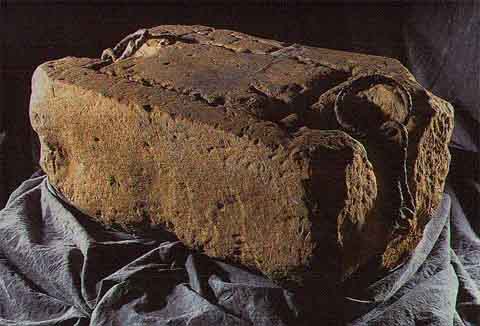You're able to wander all around the grounds and into multiple museums. There are several rooms that are still done up as they would have been in the 17th and 18th century. This castle was the primary defense of Edinburgh and the seat of the Scottish kings. It's also currently where the Scottish crown jewels are housed. Sadly I couldn't take any pictures of them, but there was so much to see. The weather actually cooperated for a bit and didn't rain until I was headed out.
Those stairs above were the original way to reach the summit, however to haul heavy cannons up, they added a more winding less grueling way to the top. Here are some of the amazing city views from the walls. Note the little cemetery below? It's for pets of the regiments stationed here.
The oldest part of the castle is St. Margaret's Chapel from the 12th century. It's a plain little building outside, but lovely on the inside. It is dedicated to Margaret, Queen of Scotland who was married to Malcolm III. It is thought that her son David I of Scotland, built the chapel in her honor. It is said that in 1093, within days of learning her beloved husband Malcolm had died, Margaret herself died of a broken heart, leaving Scotland without either King or Queen. There are several stained glass windows in the chapel that were added in 1922 as part of the ongoing restoration of the chapel. One window depicts St. Margaret herself and another shows William Wallace.
Next are the two main parts of the castle, the royal residence and the war memorial. The Royal Palace was the main residence of the Stewart kings. This is the building where the crown jewels live. The other interesting thing that is kept there is the Stone of Destiny.
The war memorial is a converted barracks block. In 1927 it was converted into a memorial for fallen Scottish soldiers of World War I. After the second world war, it was altered to include Scottish soldiers killed in all wars.
This is the Laich Hall that is still used today for formal functions.
This is the Great Hall, thought to have been built around 1511 by James IV. It is one of only two remaining medieval hammer-beam ceilings in Scotland.
Also of interest in the castle is David's tower. Or the remains of it. Around the 1380s a large tower was built. It was the equivalent of 10 storeys high and was the original royal residence. It dominated the skyline of Edinburgh for 200 years until the Lang Siege of 1573. It collapsed then and later a cannon battery was built over it. The ruins of some of the original tower were not discovered until 1912. Now there are two storeys that survive. You can only get into about three rooms, but you can see the stairs leading down to the Lord's Hall.
Then it was on to St. Giles Church, sometimes called a cathedral, which strictly speaking, it is not. Its older title is High Kirk of Edinburgh. Built in the 14th century, it's said that four of the central pillars date back to 1124. Whatever the truth, it was a lovely church.
I continued my walk down the Royal Mile to Holyrood Palace. This is the official residence of the Queen when she is in Scotland and has been used as the principle residence of the King or Queen of Scots since the 16th century. The tour takes you through several rooms of the palace, though you aren't allowed to take photos. It was pretty cool though to think that the Queen holds receptions and dinners in the very rooms you can walk through.
Adjacent to the palace are the remains of Holyrood Abbey. Founded by David I in 1128 it was used as a parish church through the 17th century. It has been a ruin since the 18th century. It suffered damage during "The War of Rough Wooing" by English troops and continued its decline after the Scottish Reformation. There is something in me that loves nothing more than a ruined abbey/cathedral. It seems impossible that something so unbelievable could simply be allowed to fall apart. Especially an abbey situated so close to the royal residence. However it happens, it makes for a beautiful sight.
Exhausted and cold, I decided it was time to find a pub. I got slightly sidetracked by a bus tour of the city. It was raining again at that point, so there weren't really any good photo ops. I guess I'll have to save that for next time. So after the bus tour I found my way back to the Grassmarket. From 1477 to 1911 it was Edinburgh's main market for cattle and horses. It was also the place where public executions took place. Apparently even up until the 1980s it was not the best area of town. Now however, it's a popular student hang out full of pubs.
I managed to duck into another one for a quick glass of whiskey. Then, wouldn't you know it, my friends wanted to go to the Scotch Whiskey Experience. Drink more whiskey? Sure, twist my arm a bit. The tour was great fun. We actually were able to taste five different whiskeys and really understand the different regions and flavors. I think I've found a few favorites that may be coming home with me. The tour also contains the largest collection of whiskey in the world. It has about 3,800 different types of whiskey.
Well after all that "tasting" we were pretty tired, but stopped to have Kurdish/Mediterranean food. Yum! I was so exhausted I couldn't even stay awake to finish the blog.
So that was all of Edinburgh for this trip. It's definitely a city I'll come back to.


































No comments:
Post a Comment